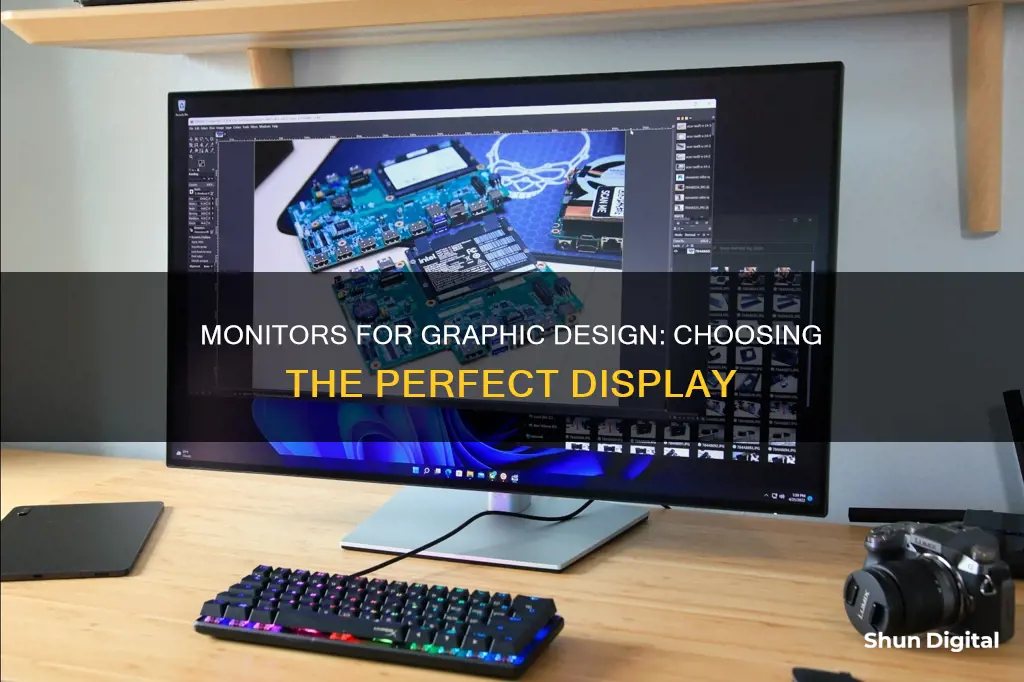
When it comes to graphic design, having the right monitor is essential. The ideal monitor for graphic design should have a high resolution, allowing designers to see their work in detail, and a wide colour gamut to ensure that the colours on the screen match those in the final printed piece.
Other important factors to consider when choosing a monitor for graphic design include the size of the screen, the type of panel, the connectivity options, and the adjustability of the stand.
Some recommended monitors for graphic design include the BenQ PD3220U, which offers a 4K screen with excellent colour accuracy, and the Asus ProArt PA32UCG-K, which provides stunning picture quality and colour representation. For those on a budget, the Xiaomi G27i is a great option, offering a 27-inch display with passable colour coverage at an affordable price.
Ultimately, the best monitor for graphic design will depend on the specific needs and budget of the designer.
| Characteristics | Values |
|---|---|
| Resolution | 4K, WQHD, QHD, FHD, WUXGA, UHD, 5K |
| Aspect Ratio | 32:9, 21:9, 16:9, 3:2 |
| Brightness | 250 nits, 300 nits, 350 nits, 400 nits, 600 nits |
| Color Gamut | sRGB, DCI-P3, Rec.709, Adobe RGB, HDR10, Dolby Vision, HDR_PQ DCI, HDR_PQ Rec2020 |
| Color Accuracy | 95% or more for Adobe RGB and DCI-P3 |
| Ports | HDMI, DisplayPort, USB-C, Thunderbolt, DVI, VGA, USB |
| Size | 27", 32", 34", 40", 42", 43", 45" |
What You'll Learn

Colour accuracy and gamut coverage
There are two types of screens that offer excellent colour accuracy: Advanced High-Performance In-Plane Switching (AH-IPS) and Twisted Nematic (TN). IPS monitors provide accurate colour reproduction and consistency when viewed at different angles, making them ideal for multi-monitor setups. They also offer different colour gamut standards, such as sRGB and Adobe RGB. sRGB is suitable for graphic design, web design, digital art and photos intended for onscreen viewing, while Adobe RGB has a wider colour spectrum and is more accurate, although it is also more expensive.
When choosing a monitor, look for one that provides at least 95% coverage of the AdobeRGB and DCI-P3 gamuts. The BenQ PD3220U, for example, offers 100% sRGB, 95% Display P3/DCI-P3 and 83% Adobe RGB coverage, ensuring excellent colour accuracy. The Asus ProArt PA32UCG-K is another option that delivers impressive colour accuracy, with 100% sRGB, 99.5% AdobeRGB, 98% DCI-P3 and 85% Rec.2020 coverage.
In addition to colour accuracy and gamut coverage, other important considerations include screen size, resolution, connectivity options and adjustability. A larger screen, such as a 27-inch or 32-inch monitor, can provide more workspace and allow you to view details more easily. A high resolution, such as 4K, will also enhance your ability to see fine details.
When it comes to connectivity, look for monitors with multiple input options like HDMI, DisplayPort, USB-C and Thunderbolt 3. Finally, ensure that your monitor is adjustable in terms of height, tilt and swivel to ensure optimal comfort and ergonomics during long work sessions.
Smaller Screens: Monitor Size Minimums for Comfortable Viewing
You may want to see also

Resolution and screen size
The size of the monitor you choose will depend on the size of your workspace and how much screen real estate you need. Larger monitors will give you more space to work with, but they can be overwhelming if you have a small desk. A 27-inch monitor is a good middle ground, offering plenty of space without being too big. If you're looking for something smaller, there are also 24-inch options available. For those who need even more space, ultra-wide monitors are an option, though they can be quite expensive.
When choosing a monitor size, it's also important to consider the resolution. A higher resolution will give you a sharper image, but it can also make text and icons appear very small. If you're working on a large monitor with a low resolution, you may find that the image looks pixelated or blurry. It's important to find a balance between screen size and resolution that works for you.
In addition to resolution and screen size, there are a few other factors to keep in mind when choosing a monitor for graphic design. Colour accuracy is crucial, as you need to be able to trust that the colours you see on your screen will match those in the final printed piece. You should also look for a monitor with good connectivity options, including HDMI, DisplayPort, and USB-C ports. Finally, make sure that the monitor is adjustable so that you can find a comfortable viewing position and avoid neck and back pain.
Resetting Your ASUS Monitor's Colors to Factory Settings
You may want to see also

Budget
When it comes to buying a monitor for graphic design, you don't have to spend a fortune to get something that will work for you. Here are some options for budget monitors that will be suitable for graphic design work.
Dell S2721QS 27 Inch Ultra-Thin Bezel Monitor
The Dell S2721QS is a 27-inch 4K UHD monitor with a sleek design and 99% sRGB colour coverage, offering precise colour accuracy. It has a 60Hz refresh rate and AMD FreeSync technology, which ensures a smooth performance. The monitor also features Picture-by-Picture and Picture-in-Picture modes, which are great for multitasking. It's a good choice for those seeking quality on a budget.
LG 27UL850 27-Inch Monitor
The LG 27UL850 is a 27-inch 4K UHD monitor with a broad colour gamut and excellent colour accuracy, covering 99% sRGB. It has USB-C connectivity, which is great for MacBook users, and Radeon FreeSync technology for smoother motion and less stuttering. The stand has a wide base, which some may find less elegant, and the on-screen control button could be more user-friendly.
ASUS ProArt Display PA278QV 27-Inch Monitor
The ASUS ProArt Display PA278QV is a 27-inch WQHD monitor with a frameless design. It has exceptional colour accuracy, adhering to international colour standards of 100% sRGB and 100% Rec. 709. It also has a 75Hz refresh rate, ensuring smooth transitions for video and animations. The monitor has USB-C connectivity and features eye comfort technology to reduce eye strain.
Philips Brilliance 279P1 27-Inch Frameless Monitor
The Philips Brilliance 279P1 is a 27-inch 4K UHD monitor with PowerSensor technology, which adjusts the screen's brightness depending on the user's presence. It has excellent colour accuracy and minimal blue light output, reducing eye strain. It also has a built-in USB-C docking station for simple data transmission and communication.
LG 24UD58-B 24-Inch Monitor
The LG 24UD58-B is a 24-inch 4K UHD monitor with FreeSync technology, ensuring seamless movement for video editors and animators. It also features on-screen control with Screen Split 2.0, allowing for easy multitasking. The stand may be bulky for some setups, and the 60Hz refresh rate might not be suitable for all animation tasks.
ViewSonic VP2768a-4K 27-Inch Monitor
The ViewSonic VP2768a-4K is a 27-inch 4K UHD monitor with exceptional colour accuracy, covering 100% sRGB and Rec.709. It has a thin-bezel design, providing a seamless viewing experience, especially for multi-monitor setups. The 60Hz refresh rate may not be ideal for gaming or high-speed video editing.
HP V27i FHD 27-Inch Monitor
The HP V27i FHD is a 27-inch FHD monitor with a micro-edge design, minimising bezels for an immersive viewing experience. It uses IPS technology, ensuring colour accuracy and wide viewing angles. It also has Low Blue Light technology to reduce eye strain. However, it has limited tilt adjustment and no built-in speakers or USB-C connectivity.
Samsung 32-Inch UJ59 4K Monitor
The Samsung 32-Inch UJ59 is a 31.5-inch 4K monitor with AMD FreeSync technology, providing smooth gameplay. It supports a billion shades of colour, ensuring accurate colour representation. It has multiple connectivity options, including HDMI and DisplayPort. The 60Hz refresh rate may not be ideal for high-end gaming, and some may prefer a higher pixel density.
BenQ PD2705U 27-Inch Monitor
The BenQ PD2705U is a 27-inch 4K UHD monitor with built-in speakers. It has excellent colour accuracy, with a 100% sRGB rec. 709 colour gamut and an average Delta E ≤3. It also has seamless connectivity options, including HDMI, USB hub, and DP ports. The 60Hz refresh rate may not be ideal for high-end video tasks.
SAMSUNG S33A 24-Inch Monitor
The SAMSUNG S33A is a 24-inch FHD monitor with a matte screen surface, reducing reflection and glare. It has a high contrast ratio of 3000:1, producing deeper blacks and brighter whites. It also has eye comfort technology, including Flicker Free technology and Eye Saver Mode, reducing eye fatigue. However, it lacks built-in USB ports and speakers.
KOORUI 24.5-Inch FHD Gaming Monitor
The KOORUI 24.5-Inch FHD Gaming Monitor has a high 170Hz refresh rate, ensuring fluidity in every frame. It also has exceptional colour accuracy, with 99% sRGB coverage. It includes eye comfort technology and versatile connectivity options, with multiple HDMI ports and a DisplayPort. The colour depth may not be as extensive as specialised design monitors.
These options offer a range of features and specifications to suit different needs and budgets, so you can find the perfect monitor for your graphic design work without breaking the bank.
Removing Crayon Marks from LCD Monitors
You may want to see also

Ports and connectivity
Let's take a closer look at each of these connection types and their benefits for graphic designers:
HDMI
HDMI (High-Definition Multimedia Interface) is a commonly used connection standard that can be found on most modern monitors. It offers a broad range of uses, including TVs, monitors, laptops, and mobile devices. HDMI cables have a 19-pin connector and are capable of delivering high-definition video and audio signals. They can also support resolutions up to 4K at 60Hz, making them suitable for graphic design work.
DisplayPort
DisplayPort is another popular connection option for monitors. DisplayPort 1.2, in particular, has doubled the bandwidth from the previous version, allowing you to connect multiple displays to a single DisplayPort connection on your computer. With DisplayPort, you can even run up to 63 separate displays from a single port. However, it's important to note that while DisplayPort cables can provide high resolutions and refresh rates, their length is typically limited to around 10 feet to maintain optimal performance.
USB-C
USB-C is a versatile connection standard that offers both data transfer and power delivery. For graphic designers, USB-C is highly convenient as it allows you to connect your laptop to the monitor, charge it, and even connect peripherals like keyboards and mice using a single cable. This simplifies your setup and reduces cable clutter. USB-C is becoming increasingly common in monitors designed for creative professionals.
Thunderbolt
Thunderbolt is a high-speed interface that offers exceptional performance. Thunderbolt 3, for example, is eight times faster than USB and has four times the video bandwidth of HDMI. Monitors with Thunderbolt support can connect to your laptop, enabling you to upload visuals to another monitor without the need for additional graphic display cables. This makes it ideal for graphic designers who need to work with multiple displays or transfer large files quickly.
In addition to these standard connections, some monitors may also offer additional connectivity options, such as DVI (Digital Visual Interface) and SD card readers. DVI ports come in two varieties: single-link and dual-link. Dual-link DVI ports have six extra pins, allowing for higher resolutions than their single-link counterparts. As for SD card readers, they can be useful for graphic designers who frequently work with images and need quick access to their files.
When choosing a monitor for graphic design, it's important to consider the specific connections you'll need based on your workflow and peripheral devices. Additionally, keep in mind that some connection types, like USB-C and Thunderbolt, can enhance your setup by providing power delivery and streamlining cable management.
Monitor Sales: Tracking Parents' Tech Purchases
You may want to see also

Curved vs flat screens
When it comes to choosing between a curved or flat screen for graphic design, there are several factors to consider. Here are some key points to help you make an informed decision:
Curved Screens:
Curved screens offer a more immersive viewing experience, providing a wider field of view and enhanced depth perception. They are designed to mimic the natural curvature of the human eye, reducing eye strain and enhancing comfort during extended use. Curved screens also minimize image distortion, glare, and reflections, optimizing visibility under challenging lighting conditions. Additionally, the aesthetic appeal of curved screens can complement a modern workspace or gaming setup. However, curved screens are generally more expensive and may require an adaptation period for users. They also tend to occupy more desk space and have limited mounting options compared to flat screens.
Flat Screens:
Flat screens are typically more budget-friendly and are versatile in terms of mounting options, making them suitable for various environments, including limited desk spaces. They offer exceptional image quality and colour accuracy, catering to entertainment enthusiasts and those seeking a cost-effective option without compromising visual quality. Flat screens are straightforward in design and manufacturing, keeping production costs lower. However, flat screens may cause eye strain due to excessive eye movement, especially with larger screen sizes.
For graphic design, the choice between a curved or flat screen depends on your specific needs and preferences. Curved screens provide an immersive experience and are suitable for detailed work, while flat screens offer sharp visuals and accurate colour representation. Consider factors such as budget, workspace constraints, and the level of immersion required for your graphic design tasks to make an informed decision.
Hooking Up Your Helix: Monitor Connection Queries Answered
You may want to see also







